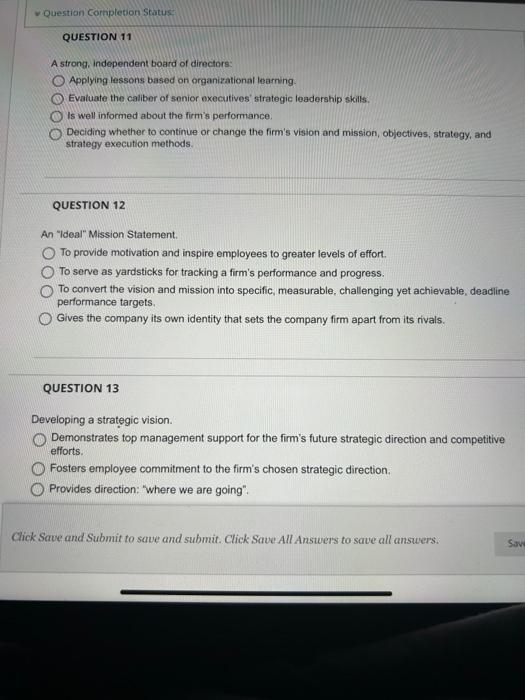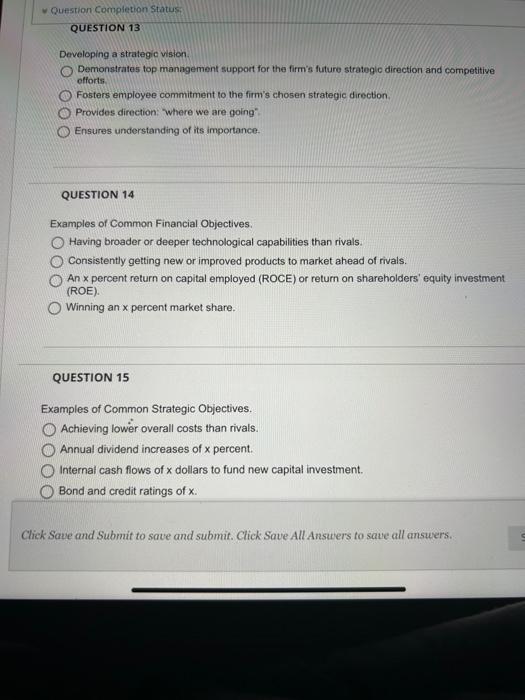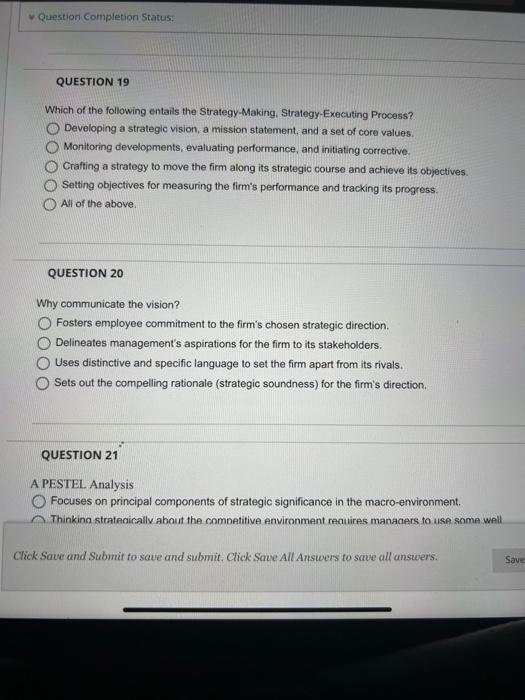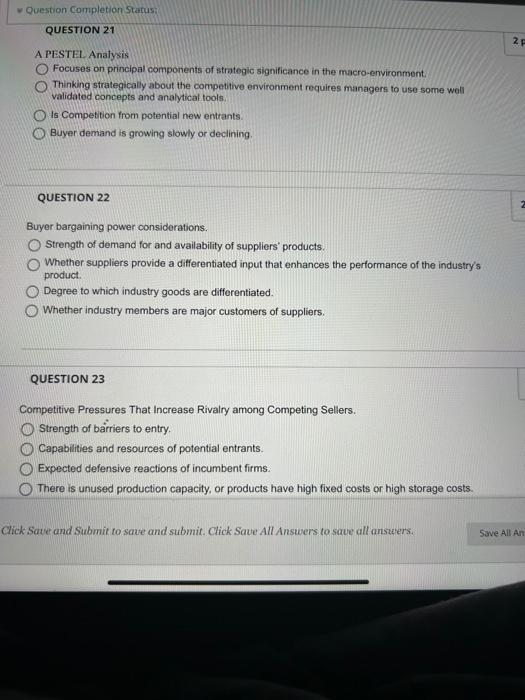A strong, independent board of directors: Applying lessons based on organizational learning. Evaluate the caliber of senior oxecutives' strategic leadership skills. Is well informed about the firm's performance. Deciding whether to continue or change the firm's vision and mission, objectives, strategy, and strategy execution methods. QUESTION 12 An "Ideal" Mission Statement. To provide motivation and inspire employees to greater levels of effort. To serve as yardsticks for tracking a firm's performance and progress. To convert the vision and mission into specific, measurable, challenging yet achievable, deadline performance targets. Gives the company its own identity that sets the company firm apart from its rivals. QUESTION 13 Developing a strategic vision. Demonstrates top management support for the firm's future strategic direction and competitive efforts. Fosters employee commitment to the firm's chosen strategic direction. Provides direction: "where we are going". Click Save and Submit to save and submit. Click Save All Answers to save all answers. Developing a strategie vision. Demonstrates top management support for the firmis future strategie direction and competitive efforta Fosters employee commitment to the firm's chosen strategic direcbion. Providos direction: where we are going: Ensures understanding of its importance. QUESTION 14 Examples of Common Financial Objectives. Having broader or deeper technological capabilities than rivals. Consistently getting new or improved products to market ahead of rivals. An x percent return on capital employed (ROCE) or return on shareholders' equity investment (ROE). Winning an x percent market share. QUESTION 15 Examples of Common Strategic Objectives. Achieving lower overall costs than rivals. Annual dividend increases of x percent. Internal cash flows of x dollars to fund new capital investment. Bond and credit ratings of x. Click Save and Submit to save and submit. Click Save All Answers to save all ansuers. Setting Objectives for Every Organizational Level. Identifies the company's product or services Identifies the customer groups or markets it is endeavoring to serve. Clarifies the firm's purpose and business makeup to stakeholders. Breaks down overall perfomance targets into targets for each of the organization's.separate units. QUESTION 17 The purposes of setting objectives. Involve radical expectations and often go unachieved, and run the risk of killing motivation, eroding employee confidence, and damaging both worker and company performance. To provide motivation and inspire employees to greater levels of effort. Focus attention on quarterly and annual performance improvements to satisfy near-term shareholder expectations. Consistently getting new or improved products to market ahead of rivals. QUESTION 18 What is Stage 1: Developing a Strategic Vision, Mission Statement, and Set of Core Values. Setting Objectives. Crafting a Strategy. Executing the Strategy. Fick Save and Submit to save and submit. Click Save All Answers to save all answers. Which of the following entails the Strategy-Making, Strategy-Executing Process? Developing a strategic vision, a mission statement, and a set of core values. Monitoring developments, evaluating performance, and initiating corrective. Cratting a strategy to move the firm along its strategic course and achieve its objectives. Setting objectives for measuring the firm's performance and tracking its progress. All of the above. QUESTION 20 Why communicate the vision? Fosters employee commitment to the firm's chosen strategic direction. Delineates management's aspirations for the firm to its stakeholders. Uses distinctive and specific language to set the firm apart from its rivals. Sets out the compelling rationale (strategic soundness) for the firm's direction. QUESTION 21 A PESTEL. Analysis Focuses on principal components of strategic significance in the macro-environment. Thinkina strateaicallv about the comnetitive environment reauires manaaers to use some well Chick Save and Submit to save and submit. Click Save All Answers to save all answers. A PESTEL Analysis Focuses on principal components of strategic significance in the macro-environment. Thinking strategically about the competitive environment requires managers to uso some woll validated concepts and analytical tools. Is Competion from potential new entrants. Buyer demand is growing slowly or declining. QUESTION 22 Buyer bargaining power considerations. Strength of demand for and availability of suppliers' products. Whether suppliers provide a differentiated input that enhances the performance of the industry's product. Degree to which industry goods are differentiated. Whether industry members are major customers of suppliers. QUESTION 23 Competitive Pressures That Increase Rivalry among Competing Sellers. Strength of bairriers to entry. Capabilities and resources of potential entrants. Expected defensive reactions of incumbent firms. There is unused production capacity, or products have high fixed costs or high storage costs. Click Save and Submit to save and submit. Click Save All Answers to save all ansuers. A strong, independent board of directors: Applying lessons based on organizational learning. Evaluate the caliber of senior oxecutives' strategic leadership skills. Is well informed about the firm's performance. Deciding whether to continue or change the firm's vision and mission, objectives, strategy, and strategy execution methods. QUESTION 12 An "Ideal" Mission Statement. To provide motivation and inspire employees to greater levels of effort. To serve as yardsticks for tracking a firm's performance and progress. To convert the vision and mission into specific, measurable, challenging yet achievable, deadline performance targets. Gives the company its own identity that sets the company firm apart from its rivals. QUESTION 13 Developing a strategic vision. Demonstrates top management support for the firm's future strategic direction and competitive efforts. Fosters employee commitment to the firm's chosen strategic direction. Provides direction: "where we are going". Click Save and Submit to save and submit. Click Save All Answers to save all answers. Developing a strategie vision. Demonstrates top management support for the firmis future strategie direction and competitive efforta Fosters employee commitment to the firm's chosen strategic direcbion. Providos direction: where we are going: Ensures understanding of its importance. QUESTION 14 Examples of Common Financial Objectives. Having broader or deeper technological capabilities than rivals. Consistently getting new or improved products to market ahead of rivals. An x percent return on capital employed (ROCE) or return on shareholders' equity investment (ROE). Winning an x percent market share. QUESTION 15 Examples of Common Strategic Objectives. Achieving lower overall costs than rivals. Annual dividend increases of x percent. Internal cash flows of x dollars to fund new capital investment. Bond and credit ratings of x. Click Save and Submit to save and submit. Click Save All Answers to save all ansuers. Setting Objectives for Every Organizational Level. Identifies the company's product or services Identifies the customer groups or markets it is endeavoring to serve. Clarifies the firm's purpose and business makeup to stakeholders. Breaks down overall perfomance targets into targets for each of the organization's.separate units. QUESTION 17 The purposes of setting objectives. Involve radical expectations and often go unachieved, and run the risk of killing motivation, eroding employee confidence, and damaging both worker and company performance. To provide motivation and inspire employees to greater levels of effort. Focus attention on quarterly and annual performance improvements to satisfy near-term shareholder expectations. Consistently getting new or improved products to market ahead of rivals. QUESTION 18 What is Stage 1: Developing a Strategic Vision, Mission Statement, and Set of Core Values. Setting Objectives. Crafting a Strategy. Executing the Strategy. Fick Save and Submit to save and submit. Click Save All Answers to save all answers. Which of the following entails the Strategy-Making, Strategy-Executing Process? Developing a strategic vision, a mission statement, and a set of core values. Monitoring developments, evaluating performance, and initiating corrective. Cratting a strategy to move the firm along its strategic course and achieve its objectives. Setting objectives for measuring the firm's performance and tracking its progress. All of the above. QUESTION 20 Why communicate the vision? Fosters employee commitment to the firm's chosen strategic direction. Delineates management's aspirations for the firm to its stakeholders. Uses distinctive and specific language to set the firm apart from its rivals. Sets out the compelling rationale (strategic soundness) for the firm's direction. QUESTION 21 A PESTEL. Analysis Focuses on principal components of strategic significance in the macro-environment. Thinkina strateaicallv about the comnetitive environment reauires manaaers to use some well Chick Save and Submit to save and submit. Click Save All Answers to save all answers. A PESTEL Analysis Focuses on principal components of strategic significance in the macro-environment. Thinking strategically about the competitive environment requires managers to uso some woll validated concepts and analytical tools. Is Competion from potential new entrants. Buyer demand is growing slowly or declining. QUESTION 22 Buyer bargaining power considerations. Strength of demand for and availability of suppliers' products. Whether suppliers provide a differentiated input that enhances the performance of the industry's product. Degree to which industry goods are differentiated. Whether industry members are major customers of suppliers. QUESTION 23 Competitive Pressures That Increase Rivalry among Competing Sellers. Strength of bairriers to entry. Capabilities and resources of potential entrants. Expected defensive reactions of incumbent firms. There is unused production capacity, or products have high fixed costs or high storage costs. Click Save and Submit to save and submit. Click Save All Answers to save all ansuers











